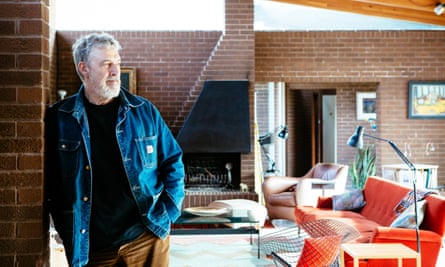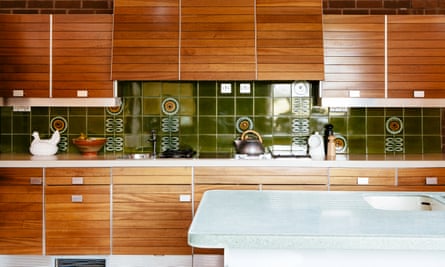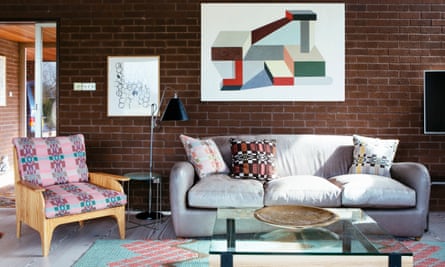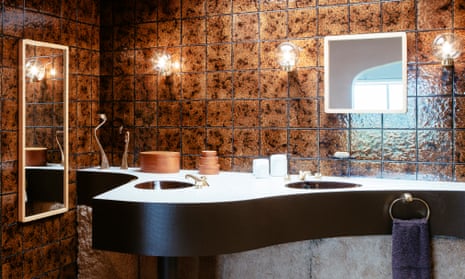At the far end of Sheridan Coakley’s 1970s bungalow is a bathroom that has been frozen in time. It is encased in high-gloss brown tiles. There are two brown sinks built into a vanity unit the shape of a baby grand piano. A 40-year-old beige shagpile carpet creeps up the walls. It’s like stepping into a bowl of chocolate ganache. “It is kind of kitsch,” admits Coakley.
The house was built by a local architect for a bachelor – an engineer with a Porsche Targa in the car port – in 1974. “Because he was an engineer, everything is such good quality,” says Coakley, who bought the property from the original owner 15 years ago. He’d been searching for a house in the area for two years before seeing it advertised in the local paper.
The three-bedroom house in Hampshire is set in 25 acres of land, which Coakley mainly rents to sheep farmers in exchange for credit at the local farm shop. It is constructed from brown engineering bricks and vast panels of aluminium-framed glazing. Above the main structure, clerestory windows separate the angled roof from the brickwork so that, from a distance, the roof appears to hover over the structure.

Since moving into the house, Coakley has installed solar panels above the garages, insulated the roof and replaced the flooring in the main living area, removing the threadbare shagpile in the vast living room and laying a Dinesen Douglas fir floor. Little else has changed. “When the owner realised I wasn’t going to knock it down and build a mock-Georgian farmhouse, he started to sell me bits of furniture,” recalls Coakley. The 1970s Heal’s rosewood furniture in the master bedroom and expansive Eames dining table came with the property. The mahogany kitchen is an original, indestructible German Poggenpohl – unaltered since it was first installed, unless you count the incongruous addition of an Aga (“It all changed when he met his future wife.”)
Coakley’s appreciation for design is longstanding. He is the founder of SCP (Sheridan Coakley Products) – a furniture brand based in Shoreditch, east London, for more than 30 years. The furniture in his home reads like a biography of the business. For instance, a circular steel and glass side table beside the sofa was designed by Jasper Morrison in 1986. It was the first product to go into production for SCP. Prior to that, Coakley had been manufacturing “knock-offs” of classic, Modernist tubular steel furniture. “I’m not ashamed of it,” he says. “The designs were very cheap and they gave access to people who couldn’t afford the overpriced licensed copies… It funded what I’m interested in, which is making new stuff.”
SCP opened on Curtain Road, Shoreditch, in 1985 with an exhibition of Philippe Starck’s furniture. “In the early days, it was just me sitting there, waiting for people to come in, six days a week,” recalls Coakley. “If people did come, they’d arrive in a taxi and leave it running outside because they had no idea where they were.” At the start, Coakley sold his designs to architects and interior designers, and stores in Europe and America: passing trade didn’t really exist until the late 90s, by which time Shoreditch had completely transformed.

“Historically, the Balzac is a very important piece for us,” says Coakley, gripping the arm of Matthew Hilton’s 1991 design, which sits – pretty battered and bruised – next to the fire in his living room. “This was the first piece of upholstery we ever made and we’re still making it today, which is a testament to Matthew’s design.” The chair is handmade at Coakley & Cox, his upholstery factory in Norfolk. It’s widely considered a modern classic and features in Taschen’s tome, 1,000 Chairs, but as Coakley explains, it was a slow burn: “It’s quite a tough business trying to make new designs, because it takes so long for people to want to buy things. We didn’t sell a Balzac for two years.” Now, the company receives regular requests for “vintage” Balzacs to be reupholstered.
Against the opposite wall is another Balzac – this time a sofa rescued from a warehouse fire. Above it hangs an abstract painting by the French designer and Memphis group member Nathalie du Pasquier. The sofa – which stopped smelling of smoke after sitting in a barn for two years – bears all the hallmarks of family life: stains, fading, Bruce the dog. Though furnished with design classics, this is a fully functioning family home.

Another standout piece is Rachel Whiteread’s Daybed. Designed by the artist in 1999 for SCP’s Please Touch exhibition, it is modelled on the empty space under a single bed. Here, it’s positioned invitingly in the centre of a 12m stretch of sliding doors that open directly on to the garden, overlooking two metal sculptures by Coakley’s son, Oscar.
The latest success story for SCP is Philippe Malouin’s 2017 Group armchair, a squat, upholstered swivel chair that is yet to find its way into Coakley’s living room. Malouin has just been named the 2018 Wallpaper designer of the year. Coakley’s prescience for design is indisputable. I ask how he goes about finding his collaborators. “We’re not particularly logical,” he replies. “We’re not big enough to behave in a methodical way.” Happily, it’s an approach that has benefited British design no end.

Comments (…)
Sign in or create your Guardian account to join the discussion